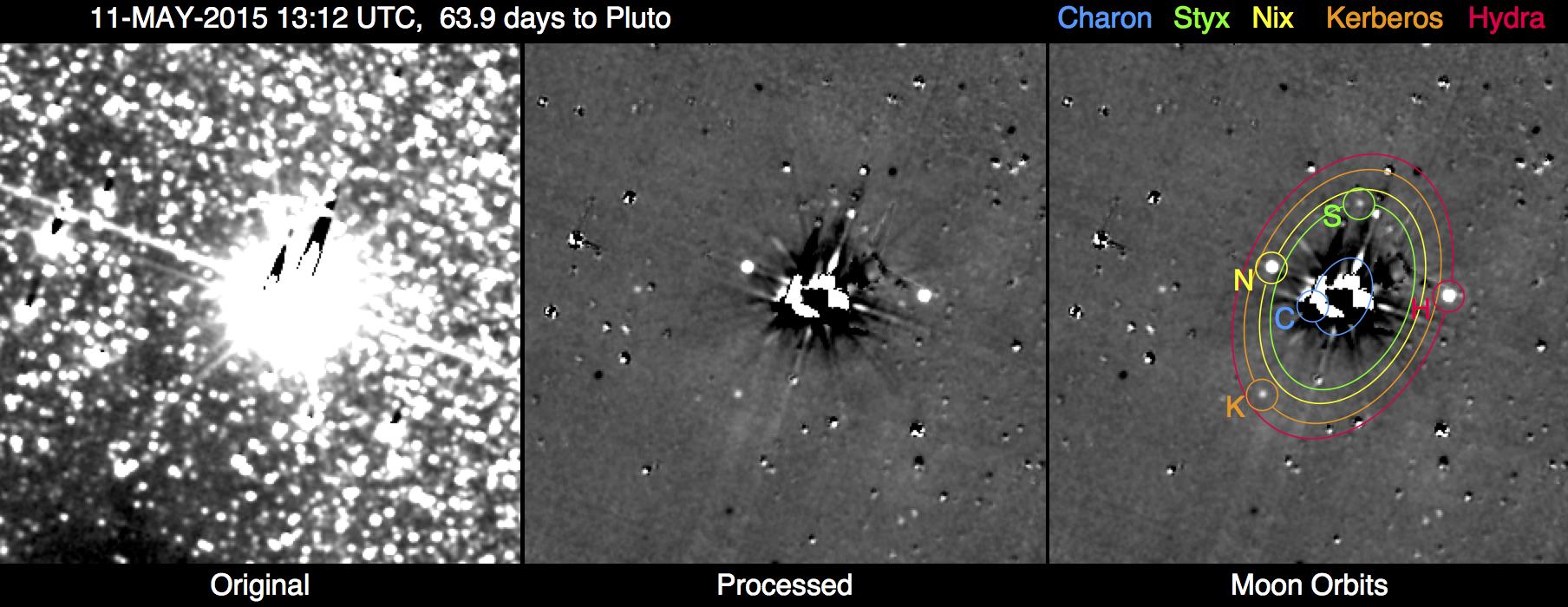
A NASA spacecraft's path to Pluto looks smooth and safe, at least for now.
The New Horizons probe is cruising toward a highly anticipated flyby of Pluto on July 14, a historic encounter that will return the first-ever up-close looks at the dwarf planet.
Earlier this month, mission team members began using New Horizons' long-range camera to hunt for undiscovered moons, rings and other features in the Pluto system that could pose a danger to the spacecraft, which is zooming along at more than 32,500 mph (52,300 km/h) relative to the sun. At such speeds, a collision with an object as small as a grain of rice could prove catastrophic, mission officials have said. [Photos of Pluto and Its Moons]
But the first hazard-search images, which were captured May 11 and May 12 at a distance of 47 million miles (76 million kilometers) from Pluto, revealed no new moons, rings or anything else to be concerned about, New Horizons team members announced today (May 28).
New Horizons spotted all five of Pluto's known moons — Charon, Nix, Hydra, Kerberos and Styx — during this initial search, and scientists determined that the spacecraft could have detected a satellite just half as bright as Styx, which is the faintest of the five.
"Any undiscovered moons outside the orbit of Pluto's largest and closest moon, Charon, are thus likely smaller than 3-10 miles (5-15 km) in diameter," mission team members wrote in an update today. "If any undiscovered rings are present around Pluto outside Charon's orbit, they must be very faint or narrow — less than 1,000 miles [1,600 km] wide or reflecting less than one 5-millionth of the incoming sunlight."
The Pluto hazard hunt is far from over, however; the campaign involves roughly weekly observations through July 1, mission representatives have said. The next round of images will be captured from May 29 to May 30, and should achieve twice the sensitivity of the initial batch.
Get the Space.com Newsletter
Breaking space news, the latest updates on rocket launches, skywatching events and more!
If the search turns up anything seriously worrisome, New Horizons' handlers have two options at their disposal, which can be employed in tandem if need be.
First, the team could divert the spacecraft from its planned trajectory — which takes it within 7,800 miles (12,500 km) of Pluto's surface — to one of three alternate routes. (Handlers could do this up until July 4, after which it would be too late.) Second, team members could point the probe's high-gain antenna forward, using this feature like a shield.
New Horizons will likely not have to resort to such measures, mission team members have said; all analyses and observations to date suggest that the spacecraft's current trajectory is quite safe.
The $700 million New Horizons mission launched in January 2006. The probe is currently almost 2.95 billion miles (4.75 billion km) from Earth, and it's getting about 750,000 miles (1.2 million km) closer to Pluto every day.
Follow Mike Wall on Twitter @michaeldwall and Google+. Follow us @Spacedotcom, Facebook or Google+. Originally published on Space.com.
Join our Space Forums to keep talking space on the latest missions, night sky and more! And if you have a news tip, correction or comment, let us know at: community@space.com.

Michael Wall is a Senior Space Writer with Space.com and joined the team in 2010. He primarily covers exoplanets, spaceflight and military space, but has been known to dabble in the space art beat. His book about the search for alien life, "Out There," was published on Nov. 13, 2018. Before becoming a science writer, Michael worked as a herpetologist and wildlife biologist. He has a Ph.D. in evolutionary biology from the University of Sydney, Australia, a bachelor's degree from the University of Arizona, and a graduate certificate in science writing from the University of California, Santa Cruz. To find out what his latest project is, you can follow Michael on Twitter.









